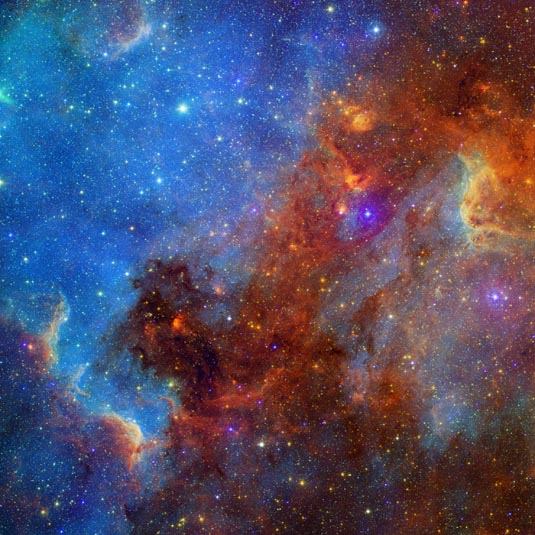
Description: Emission nebula
Position (J2000): RA 20h 55m 33.8s Dec 44° 7' 50.9"
Distance: 2,000 Light Years
Field of View: 2.3 x 2.3 degrees
Constellation: Cygnus
Image credit: NASA/JPL-Caltech/L. Rebull (SSC/Caltech)/D. De Martin
Release Date: 2011-02-10
Link to Spitzer infrared only
ABOUT THIS IMAGE:
This new view of the North America nebula combines both visible and infrared light observations, taken by the Digitized Sky Survey and NASA's Spitzer Space Telescope, respectively, into a single vivid picture.
The nebula is named after its resemblance to the North America content in visible light, which in this image is represented in blue hues. Infrared light, displayed here in red and green, can penetrate deep into the dust, revealing multitudes of hidden stars and dusty clouds. Only the very densest dust clouds remain opaque, like the dark bands seen in the "Gulf of Mexico" area.
Clusters of young stars (about one million years old) can be found throughout the image. Slightly older but still very young stars (about three to five million years) are also liberally scattered across the complex, with concentrations near the "head" region of the Pelican nebula, which is located to the right of the North America nebula (upper right, bluish portion of this picture).
In this combined view, the visible part of the spectrum from the Digitized Sky Survey is represented in blues and blue-green hues. The Spitzer component contains data from the infrared array camera. Light with a wavelength of 3.6 microns has been color-coded green; 4.5-micron light is orange; 5.8-micron and 8.0-micron light are red.
The North America nebula still has a mystery surrounding it, involving its power source. Nobody has been able to identify the group of massive stars that is thought to be dominating the nebula. The Spitzer image, like images from other telescopes, hints that the missing stars are lurking behind the Gulf of Mexico portion of the nebula. This is evident from the illumination pattern of the nebula, especially when viewed with the detector on Spitzer that picks up 24-micron infrared light. That light appears to be coming from behind the Gulf of Mexico's dark tangle of clouds, in the same way that sunlight creeps out from behind a rain cloud.
The nebula's distance from Earth is also a mystery. Current estimates put it at about 1,800 light-years from Earth. Spitzer will refine this number by finding more stellar members of the North America complex.